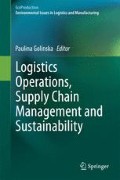Abstract
This chapter develops a green supply chain design model that incorporates the cost of carbon emissions into the objective function. The goal of the model is to simultaneously minimize logistics costs and the environmental cost of CO2 emissions by strategically locating warehouses within the distribution network. A multi-echelon joint inventory-location model that simultaneously determines the location of warehouses and inventory policies at the warehouses and retailers is developed. The supply chain design model also integrates published experimental data to derive nonlinear concave expressions relating vehicle weight to CO2 emissions as a transportation costs. The objective function determines the number of warehouses to establish, their location, the sets of retailers that are assigned to each warehouse, and the size and timing of orders for each facility to minimize the sum of inventory, shipping (including the CO2 emissions effect), ordering, and location costs, while satisfying end-customer demand. The developed model is Mixed Integer Nonlinear model solved by using CONOPT solver in GAMS.
Access this chapter
Tax calculation will be finalised at checkout
Purchases are for personal use only
References
Abdallah T, Diabat A, Simchi-Levi D (2012) Sustainable supply chain design: a closed-loop formulation and sensitivity analysis. Prod Plan Control 23(2–3):120–133
Abdallah T, Diabat A, Rigter J (2013) Investigating the option of installing small scale PVs on facility rooftops in a green supply chain. Int J Prod Eco 146(2):465–477
Al Dhaheri N, Diabat A (2010) A mathematical programming approach to reducing carbon dioxide emissions in the petroleum refining industry. In: Engineering Systems Management and Its Applications (ICESMA), 2010 Second International Conference on, IEEE
Al Zaabi S, Al Dhaheri N, Diabat A (2013) Analysis of interaction between the barriers for the implementation of sustainable supply chain management. Int J Adv Manufact Technol 68(1–4):895–905
Daskin MS (1995) Network and discrete location: models, algorithms, and applications. Wiley, New York
Diabat A, Aouam T, Ozsen L (2009) An evolutionary programming approach for solving the capacitated facility location problem with risk pooling. Int J Appl Decis Sci 2(4):389–405
Diabat A, Richard J P, Codrington C W (2013a) A Lagrangian relaxation approach to simultaneous strategic and tactical planning in supply chain design. Annals of operation research 203(1):55–80
Diabat A, Abdallah T, Al-Refaie A, Svetinovic D, Govindan K (2013b) Strategic closed-loop facility location problem with carbon market trading. IEEE Trans Eng Manage 60(2):398–408
Diabat A, Abdallah T, Henschel A. (2013c) A closed-loop location-inventory problem with spare parts consideration. Comput Oper Res (in press)
Diabat A, Abdallah T, Le T (in press) A hybrid tabu search based heuristic for the periodic distribution inventory problem with perishable goods. Ann Oper Res (in press)
Diabat A, Battaïa O, Nazzal D (2014) An improved lagrangian relaxation-based heuristic for a joint location-inventory problem. Computers & Operations Research, in press.
Elhedhli S, Merrick R (2012) Green supply chain network design to reduce carbon emissions. Transp Res Part D: Transp Environ 17(5):370–379
Facanha C, Horvath A (2007) Evaluation of life-cycle air emission factors of freight transportation. Environ Sci Technol 41(20):7138–7144
Govindan K, Popiuc M. N., Diabat A (2013) Overview of coordination contracts within forward and reverse supply chains. J Clean Prod 47:319–334
Govindan K, Diabat A, Popiuc M. N (2012) Contract analysis: A performance measures and profit evaluation within two-echelon supply chains.Comput Indust Eng 63(1):58–74
Hervani AA, Helms MM, Sarkis J (2005) Performance measurement for green supply chain management. Benchmarking: Int J 12(4):330–353
Le T, Diabat A, Richard J-P, Yih Y (2013) A column generation-based heuristic algorithm for an inventory routing problem with perishable goods. Optim Lett 7(7):1481–1502
McKinnon AC (2007) CO2 emissions from freight transport in the UK. Logistics Research Centre, Heriot-Watt University, Edinburgh
Merrick R, Bookbinder JH (2010) Environmental assessment of shipment release policies. Int J Phys Distrib Logistics Manage 40(10):748–762
Miranda PA, Garrido RA (2006) A simultaneous inventory control and facility location model with stochastic capacity constraints. Netw Spat Econ 6(1):39–53
Nozick LK, Turnquist MA (2001) A two-echelon inventory allocation and distribution center location analysis. Transp Res Part E: Logistics Transp Rev 37(6):425–441
Rappold JA, Van Roo BD (2009) Designing multi-echelon service parts networks with finite repair capacity. Eur J Oper Res 199(3):781–792
Shen ZJ, Qi L (2007) Incorporating inventory and routing costs in strategic location models. Eur J Oper Res 179(2):372–389
Author information
Authors and Affiliations
Corresponding author
Editor information
Editors and Affiliations
Rights and permissions
Copyright information
© 2014 Springer International Publishing Switzerland
About this chapter
Cite this chapter
Alkaabneh, F., Kaya, A., AlHammadi, J. (2014). A Joint Inventory-Location Model with CO2 Emission Taken into Account in Design of a Green Supply Chain. In: Golinska, P. (eds) Logistics Operations, Supply Chain Management and Sustainability. EcoProduction. Springer, Cham. https://doi.org/10.1007/978-3-319-07287-6_39
Download citation
DOI: https://doi.org/10.1007/978-3-319-07287-6_39
Published:
Publisher Name: Springer, Cham
Print ISBN: 978-3-319-07286-9
Online ISBN: 978-3-319-07287-6
eBook Packages: Earth and Environmental ScienceEarth and Environmental Science (R0)

